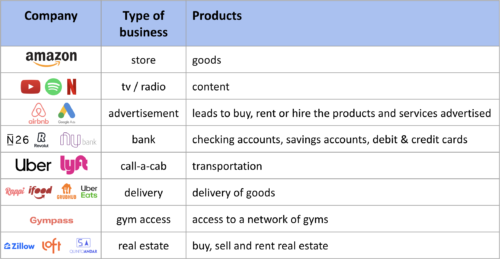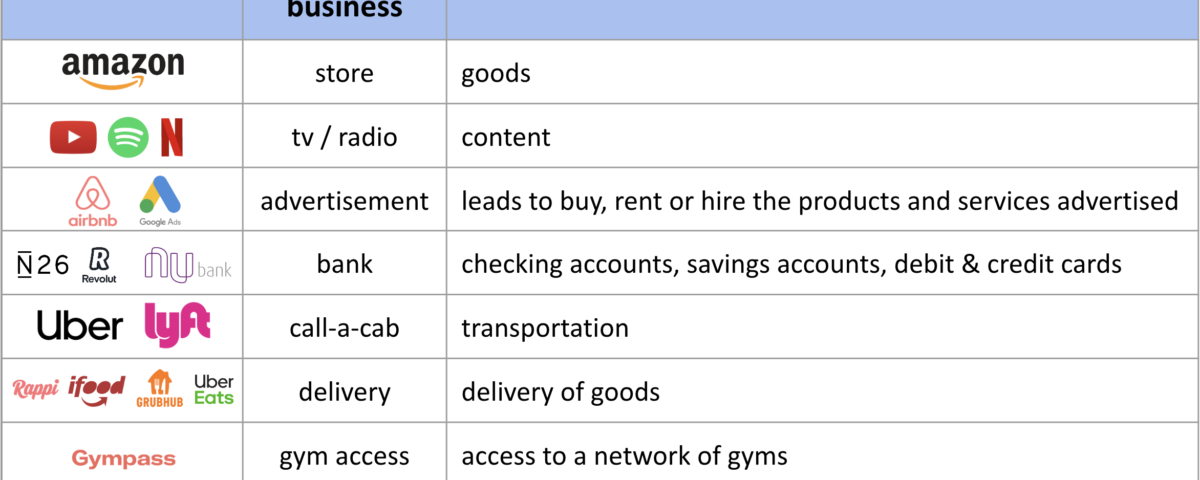
Uncertainty and digital transformation
19 de February, 2024
Type of company vs digital maturity
5 de March, 2024This article is another excerpt from my newest book “Digital transformation and product culture: How to put technology at the center of your company’s strategy“, which I will also make available here on the blog. So far, I have already published here:
- About the book
- Part 1: Concepts
- Chapter 1: The so-called digital transformation – Project and Product
- Chapter 2: Uncertainty and digital transformation
Let’s now dive into chapter 3, about:
Types of company
A fundamental understanding of the success of digital transformation in organizations lies in the concept of the type of company. This concept is used to categorize companies based on the type of product or service they offer to customers, considering the use of technology in that product or service. From this perspective, we can identify two main categories of companies: digital companies, whose product is technology itself, and traditional companies, whose product is not technology but can enhance their business through its use.
This directly impacts how individuals responsible for digital transformation will perform their tasks. By comprehending how your company is classified, it becomes possible to tailor the digital transformation strategy to meet the specific needs of your market and maximize results.
Digital companies
Digital companies are businesses whose sold product is the software or technology that the company develops. We are all familiar with digital companies such as Google, with its main focus on. The companies you mentioned—Google with its primary products Google Search and Gmail, Amazon Web Services (AWS), Facebook, Instagram, WhatsApp, SAP, Salesforce, and Zendesk—are digital companies where technology is at the core of their products. Without technology, these companies wouldn’t exist. Can you imagine Google without the Google Search software? Or Instagram without the Instagram app? Or Zendesk without the Zendesk software? In these cases, technology is indispensable to the functionality and existence of the respective companies.
In these companies, product management is at the core of the business. Product management is responsible for defining a significant portion, if not all, of the vision and strategy of the company. The role of technology professionals is central in both defining and executing this strategy.
Traditional companies
On the other end of the spectrum, there are what we can call traditional companies. These companies sell products and services that are not digital. However, all of them, in one way or another, are undergoing some form of digital transformation, learning to use digital technologies to enhance their businesses.
These are some examples of improvements that can result from the use of digital technologies:
- Enhanced customer relationships.
- Data collection for generating insights. *Innovation through rapid experimentation.
- Increasedspeedandqualityofprocessesthroughautomation.
I will mention some well-known Brazilian examples. Itaú, one of the largest Brazilian banks founded in 1924, is heavily investing in becoming digital with Internet Banking and its application. Periodically, they launch TV campaigns to showcase this transformation. Magazine Luiza, a physical retail chain founded in 1957, also invests significantly in its digital presence. They are well-known in Brazil for their online presence and mobile applications. Lopes is a Brazilian real estate company, a leader in its sector in the country. It went public in December 2006 on B3, the Brazilian stock exchange headquartered in São Paulo, and in October 2019, it conducted a follow-on, issuing more shares to be traded in the capital market, raising R$147 million. The funds raised focus on the company’s digital transformation, which I led between 2020 and 2022. Other good examples of traditional companies investing in a digital presence are airlines and hotels. They have websites and apps to interact with customers and allow them to purchase tickets and make reservations.
In traditional companies, their products or services have existed and likely thrived for a long time without digital technology. Executives and shareholders of these companies are beginning to understand how digital technologies can impact their businesses and are investing in digital transformation.
In these companies, technology professionals are seen as enablers but not the core. Typically, they are part of a team called the “digital team.” These individuals will need to carve out their space by demonstrating how technology can enhance business operations.
The third type of company: born-digital traditional companies
This type of company has traditional products or services that could exist without technology. However, as they incorporate technology from the outset as a strategic capability, they are considered technology companies — and in a way, they are, as technology is at the core of their strategy. On the other hand, when we take a closer look, their product is not technology. Their products are enhanced by digital technology, much like in traditional companies.
 Examples of born-digital traditional companies
Examples of born-digital traditional companies
Amazon products are goods (books, computers, mobile phones, etc.). Amazon is a store that sells these goods. Amazon has been opening physical stores in recent years, but with a significant amount of technology to enhance the shopping experience. It’s a fairly traditional business but with a considerable focus on technology.
It’s greatly empowered by technology through e-commerce. The product of Netflix and YouTube is video content. We don’t subscribe to Netflix because their app is incredible or because its algorithm makes good recommendations. We subscribe because they have series and movies we want to watch. That’s why one of the most important areas within Netflix is the content selection and creation department. Similarly, the product of Spotify is audio content. Airbnb operates as a short-term rental classifieds business. Google AdWords is also a classifieds company but for any product or service.
Nubank, a Brazilian digital bank similar to N26 and Revolut, offers credit card and banking services like any other bank. However, since Nubank was born digital, it has leveraged technology to enhance its business, providing a seamless experience for its customers directly through online channels. As a result, it hasn’t needed an extensive network of bank branches throughout the country to serve its customers. The main service that Uber and Lyft offer is transportation. Rappi, a Colombian delivery service, iFood in Brazil, GrubHub and UberEats in the United States are, as described, food delivery services. Gympass is a corporate benefit that HR departments hire to provide employees with access to over 50,000 gyms and studios worldwide.
QuintoAndar and Loft are two Brazilian companies in the real estate market, similar to Zillows in the US, dealing with property buying, selling, and renting. They rely on technology to offer a great experience for those seeking properties to buy or rent, for those looking to sell or rent their property, and for real estate brokers. In this type of company, product management and the technological aspect are crucial for delivering innovative and customer-centric solutions.
In this type of company, product management and the business area together form the core of the company. Business and product management are equally important and share responsibility for defining and executing the strategy, working as a unified team. For example, in Netflix’s strategy discussions, there are certainly conversations about what type of content to invest in, as well as how technology can help determine those content investments. This collaborative effort between product management and business is the reason for the success of this type of company.
Corollary: product management + business!
Traditional companies, to compete with digital-native counterparts, will need to incorporate digital product management into their daily operations.
Business + product management = one team
Product management should be as important as business areas and should share responsibility for defining and executing the company’s strategy. Ideally, these two areas should work as one team, focused on combining business strategies with digital strategies to maximize results.
This joint effort between product management and business is a critical factor for successful digital transformations.
Corollary 2: Extinction of traditional companies?
A second corollary derived from this classification of companies is that with the increasing knowledge and understanding of the potential uses of digital technologies, fewer and fewer traditional companies will be created. If a company with a non-digital product or service does not consider using digital technologies to enhance its business, its chances of success will be virtually nil. Imagine starting any new business without using digital technologies to communicate with customers and increase operational efficiency. A bank without internet banking. A TV or radio channel without internet transmission. A store without an online presence to sell and serve customers. For this reason, the vast majority of companies emerging from now on will either be digital or traditional companies born digital.
Recommendation
Try to understand the nature of your company, whether it is digital, traditional, or a traditional digital native. Having this understanding is crucial to clarify the role of technology and, consequently, the people tasked with bringing technology to enhance the business.
If your company is traditional,it is very important that product management be as important as business areas and share responsibility for defining and executing the company’s strategy. Only then can you compete with traditional digital natives.
Furthermore, if you are thinking of starting a new company, there is no way to not consider digital technologies as an important part of your strategy.
Summing up
There are three types of companies, classified based on the type of product or service offered:
- In digital companies, the product sold by the company is the software or technology developed by the product development team.
- In traditional companies, the product or service sold by the company likely has existed for many years without technology but can be significantly enhanced with digital technologies.
- In born-digital traditional companies, the product sold by the company could exist without technology, but technology greatly enhances the product and is at the core of the com- pany’s strategies.
Workshops, coaching, and advisory services
I’ve been helping companies and their leaders (CPOs, heads of product, CTOs, CEOs, tech founders, and heads of digital transformation) bridge the gap between business and technology through workshops, coaching, and advisory services on product management and digital transformation.
Digital Product Management Books
Do you work with digital products? Do you want to know more about managing a digital product to increase its chances of success, solve its user’s problems, and achieve the company objectives? Check out my Digital Product Management books, where I share what I learned during my 30+ years of experience in creating and managing digital products:
- Digital transformation and product culture: How to put technology at the center of your company’s strategy
- Leading Product Development: The art and science of managing product teams
- Product Management: How to increase the chances of success of your digital product
- Startup Guide: How startups and established companies can create profitable digital products


